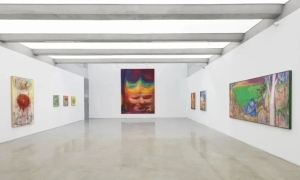法国思想家布莱瑟•帕斯卡(Blaise Pascal,1623—1662)在《思想录》(Pensées)中写道:“人只不过是一根芦苇,是自然界最脆弱的东西,但它却是一根会思维的芦苇。” 然而,承认人的脆弱似乎不是人类尤其不是西方人的主导思想,具有“人本主义”世界观的西方人总是愿意标榜人类作为万物之灵长的强大与伟力。早在古希腊时代,伟大的悲剧作家索福克勒斯(Sophoclēs,约前496—前406)就说过这样的话:“在自然界中即使再大的力量,也没有超过人的力量。” 即使脆弱是人类生命的客观属性,人们也总是有意无意地加以回避和掩饰,我们甚至渴望征服人类自身的脆弱性。披览人类艺术史,我们可以看到无以数计的颂扬人类伟大坚强的杰作,古希腊神话中的大力神赫拉克勒斯(Helacles)更是西方历代艺术家钟爱的对象,我们几乎看不到表现人类脆弱的艺术作品。西方现代主义和后现代主义艺术对人性的种种缺陷进行了深入的挖掘,但也没有一个艺术家明确表现过生命的脆弱性。因此,当武明中致力于通过绘画表现人类生命的脆弱性时,他无疑揭示了人性的新纬度,开拓了艺术的新领域。
武明中不是哲学家,但他从当代世界和现实生活的切身体验中,感到了生命的脆弱。为了表现这种不可言传的脆弱感,艺术家在画布上发明了一种装着红葡萄酒的透明玻璃人像。这样一种奇异别致的艺术形象看似灵感乍现、信手拈来的偶然产物,但却是他经过深思熟虑、反复探索的结果;玻璃人像是透明的,但这些形象的含义却未必一览无余;除了警示生命的脆弱,武明中的透明玻璃人像还蕴含着更丰富更复杂的艺术史含义。
武明中第一批成熟的作品完成于20世纪90年代中后期,当时的中国艺坛,政治波普艺术、玩世现实主义和艳俗艺术正盛极一时,武明中顺应时代潮流,以一组具有波普艺术风格的作品表明自己积极介入当代艺术的立场。我之所以将这组作品归类于波普艺术,是因为武明中采用了波普艺术惯用的现成图像挪用策略,但实际上它们与当时的政治波普艺术有着本质的差别,武明中挪用的图像不是那些作为政治符号的领袖人物,而是一些带有条形码的西方美术史上的著名形象,而且,他还通过三联画的形式,用并置的办法,描绘了一张正张着大嘴打哈欠的人脸。因此,这类作品在波普艺术特点之外又具有新表现主义绘画的品质。根据武明中自己的说法,这些作品表达的是对消费社会的困惑。在我看来,这些作品的真正意义在于试图通过超越国家政治、关注人类共同的生存境遇,达到对中国当代政治波普艺术的颠覆。
从2000年开始,武明中创造了一种带有卵形脑袋的人像,也就是一种身体四肢和衣着高度写实,但五官略而不做,头部被简化成鸡蛋状的人物形象。武明中在现实生活中注意到这样一个现象,就是在官场和外交场合,各种人物特别是政客的相貌和五官并不是人们关注的焦点,人们更看重的是他们的身份,而且,他们的手势和动作往往代表着人物的角色,更能体现事件的性质、过程和结果,虽然这些动作通常带有公式化色彩,但它们具有约定俗成、一望即知的象征含义。以这样的人物形象,武明中创作了题为《接见》、《谈判》、《投票》和《宣誓》等现实题材的作品。尽管在这些作品中,我们看不到人物的相貌,但他们握手、鼓掌、举手和举杯的动作姿态已经将人物角色和事件结果交待得一清二楚。这些作品的素材主要来自大众传播媒体,其主题的选择再一次突破了狭隘的民族性,显示出画家敏锐而开阔的世界主义眼光。
2002年,武明中的个人艺术史翻开了崭新的一页,他的画布上突然了出现一种人们从未见过的艺术形象——装着XO威士忌的透明玻璃人像,通过这种形象,艺术家希望表达他从现实生活和个人情感经历中领悟到的生命的脆弱感,人世间那些原以为坚不可摧的东西其实是脆弱不堪的。武明中在喟叹脆弱之余,不禁产生了通过绘画表达这种脆弱,也就是将这种脆弱的意念变成视觉形象的冲动。按照象征主义者的说法,“任何一种观念,都存在一种能够将之传达的视觉形象”。然而,究竟什么样的物象能表达脆弱这样一种抽象的质感和心理的感受呢?艺术家开始了艰难的寻找和实验,终于,玻璃进入了武明中的画面。从此,一个全新的艺术世界在他面前豁然洞开。
根据古罗马作家大普林尼(Pliny the Elder / Gaius Plinius Secundus,23—79)的《自然史》(Historia naturalis)记载,玻璃是在公元前3500年左右由腓尼基人(Phoenician)最早发明的,它是一种由石英砂和碳酸钠经高温熔化、冷却形成的化合物。在西方人眼里,玻璃是上帝赐予人类的最美丽的礼物。武明中将这样一种既坚硬又易碎、充满矛盾的神奇物质,作为貌似坚强实则脆弱的人类生命的象征,真是再贴切不过了。经过反复试验,武明中终于创作出了第一幅成功的玻璃人像,其标题为《嘿嘿!》,画面描绘的是意大利著名光头裁判皮耶尔路易吉•科利纳(Pierluigi Collina)。这个意大利人仿佛被施了魔法,一个血肉之躯焕然变成了玻璃制品,并且在这个玻璃人的体内还装满了橘红色的XO威士忌。在玻璃人像绘画的试验中,武明中发现,仅仅单纯地画出一个无色而又透明的玻璃人像,给人的视觉刺激是很微弱的,因此,在画出玻璃人像的同时,武明中就将玻璃人像装上了XO威士忌,有了这种液体,既强化了玻璃的质感,又增加了画面的色彩和视觉冲击力。由于找到了可行的办法,艺术家一发而不可收,接着创作了“朋友,小心轻放!”、“嗨,小心!”、“拍吧!”和“爱能持续多久?”等大量作品。这些玻璃人既有头像,又有胸像,还有立像;有单人像,也有人物众多的群像;有静止的姿态,更有活动的身影。许多头像和胸像有着高脚玻璃杯的底座,那纤细的支柱仿佛一触即碎,而那些在基座上倾倒的人像更是即将坠地,瞬间化为碎片。虽然肉体变成了玻璃,但这是一种高度写实的人物画,画中每个人物的相貌、神情乃至汗珠仍一如常态、逼肖真人。
从2005年开始,武明中迷恋上丙烯颜料中的荧光桃红,与此同时,他还将他的玻璃人容器中的液体换成了红葡萄酒,由荧光桃红、永固红和深红色画成的葡萄酒更加绚丽夺目,为了突出主体形象,画面的背景更多地采用了灰白色。色彩学和视觉心理学告诉我们,红色是光波最长、穿透力最强、感知度最高的颜色,它往往使人联想到太阳、火焰和鲜血等物象,常常使人产生欢快、激动和亢奋的心理反应。红色既象征喜庆和希望,又代表暴力和危险。在武明中的绘画中,红色无疑具有危险、警告和禁止的象征含义。虽然从形式上看,武明中的这种玻璃人像属于单色画,但由于其独特的语言、奇异的形象和强烈的红色,作品有着巨大的视觉冲击力,令人过目难忘。
武明中的绘画素材基本上来自报纸、杂志和网络等大众传播媒体,他以图片为蓝本,通过想象将其转化为玻璃人像。实际上,武明中描绘的是一种虚拟的玻璃制品,制造的是一种超现实主义的幻觉。由于没有真实的玻璃人可供写生,一个装有威士忌的玻璃瓶成了武明中忠实的模特儿。可以说,武明中作品中的所有玻璃人像都是从这个玻璃瓶蜕变而成的。
由于武明中的玻璃人像绘画是如此新颖、如此独特,以致长期以来评论家始终难以将其归类。从风格学上看,武明中的这类作品具有显而易见的象征主义(Symbolism)特征,武明中采用的艺术语言符合象征主义的定义,即“用具体的人们可以感知的物象来暗指某种抽象的不可感知的人类情感或观念”。在西方传统的象征主义绘画作品中,在人物形象之外,画家往往利用某种特定的道具来表达某种特定的寓意,例如,鸽子象征和平,玫瑰代表爱情,百合表示纯洁,骷髅暗示死亡。西方象征主义绘画中的物象或道具所具有的象征含义有些是全人类公认的,有些只有在特定的文化语境中才能成立。例如,在基督教文化中,红葡萄酒象征基督的血液,面包代表基督的肉体,这样的类比关系和象征意义就是非基督教文化圈的人所不熟悉的。武明中将人像画成玻璃制品,用玻璃来象征人的脆弱,而玻璃的脆弱性又是人所共知的;包装箱上的玻璃杯图形表示“易碎物品,小心轻放”,是一个世界通行的标识。红色代表危险和警告也是人类普遍认同的,“绿灯行,红灯停”是全球统一的交通信号。不过,传统的象征主义绘画多取材于文学作品,而武明中的玻璃人像则完全取自当代世界中的真实人物,作品具有更强烈的现实主义精神。因此,如果一定要我给武明中的玻璃人像绘画贴上风格的标签,我愿意将其称为“象征现实主义”(Symbolist realism)。
虽然武明中的玻璃人像是在画布上完成的,但它带有强烈的观念主义特征,我们甚至可以说,武明中的玻璃人像是架上绘画和观念主义的混合体,而这样的综合性也正是中国当代艺术的普遍特征。在武明中的作品中,既有关注人生的现实主义精神,又有幻想虚拟的超现实主义品质;既有托物表意的象征主义手法,又有图像挪用的波普艺术策略。武明中自己也说:“画玻璃人像的时候,我把自己找全了,体验、观念和技法,所有的知识和思想都用上了。”在我看来,高超的写实功力是武明中获得成功的重要基础,纯粹的绘画性使得这些玻璃人像作品更具独特性。武明中的绘画告诉我们,“绘画没有死亡”,它有着巨大的生命力和无穷的可能性。
2008年,武明中又将它的创作扩展到了装置艺术和数码影像艺术领域。在“第七届上海双年展”(7th Shanghai Biennial)中,武明中展出了绘画、装置和影像三合为一的作品《国际饭店501》,其中的影像作品,让观众通过晃动的红葡萄酒透视上海人民广场的人群和建筑,让人产生一种既华丽又虚幻的心理感受,真是妙不可言。在“第三届西班牙塞维利亚国际当代艺术双年展”(3rd International Biennial of Contemporary Art, Sevilla, Spain)上,武明中展出的是影像作品《城市》,同样表现的是通过装有红色葡萄酒杯看到的扭曲而又浮华的当代物质世界。
武明中的玻璃人像形式新颖、风格独特,但它们的意义还不在于风格学层面,换一句话说,如果仅仅从风格学的角度来读解武明中的玻璃人像,我们就会错失这些作品的真正价值。因此,我更愿意从作品的内在含义和中国当代艺术发展的角度来解读武明中的作品。
我们知道,坚强和伟大是人类追求的目标,也是人类文明发展的动力,从某种意义上说,一部人类文明史就是人类努力征服自然、不断走向强大的历史,尤其是进入工业文明时代,人类更是创造了空前强大的物质文明。有人说,地球上的人类从来没有像工业文明时代这样活得如此高贵。但是,具有讽刺意味的是,人类创造了强大的物质文明,人类自身却越来越脆弱;在工业文明时代,人类的精神性日益丧失,对于物质的依附,导致人类自身也被物质化了。我们看到,随着时间的推移,出现在武明中玻璃人像行列中的人物越来越多,除了不知名的普通人之外,还有各国元首、世界明星、商业巨人、社会名流和大众偶像,武明中甚至将世界艺术史上的经典作品也变成了玻璃制品。在许多作品中,武明中还将众多人物和盛大场面布置在箱子里,意在讽喻人们身处危险而毫不自知,也是对乐观主义者的提醒。实际上,武明中揭示的不仅是人类生命的脆弱性,还包括人与人之间的关系、自然环境的脆弱性。在武明中眼里,除了永恒的时间,这个星球上几乎没有坚实的东西。生命、爱情、友谊、权力、政治、文明、信仰乃至精神,一切都不是坚不可摧永远不变的。至此,武明中似乎进入了“看破红尘”的佛教境界,但实际上,武明中并不是一个悲观主义者,他只是比常人多了一份理性、多了一份清醒,他的作品带给我们的是哲理和警醒,而不是恐惧和绝望。
武明中的玻璃人像是全球化、信息化时代特有的产物,它不仅具有当代性,而且具有国际性。必须承认,武明中透明玻璃人像是对人性的探寻和质疑,脆弱性具有人类普适性(universalism)。不分民族和种族,无论男女老幼,脆弱是当今世界所有生命的共同感受。武明中说:“我认为,中国艺术家不必彰显自己的民族身份或民族符号,应该凸现个性化色彩,个人体内流动着民族的血液,不必加以强调,艺术家应该具有国际的胸怀和个人的视角。”艺术家将所有的人物都画成玻璃人,还有另一层涵义,这就是人是简单的、同质的(homogeneous),不仅每个人的物质构造没有区别,每个人的需要和欲望也都是相同的。简而言之,武明中的玻璃人像是工业文明时代消费社会中脆弱化、物质化和同质化的人类生命的写照。这些作品既是对人类的讽喻,又是对生命的警示。
武明中的绘画意味着, 21世纪的中国当代艺术已经走出了对西方艺术的模仿,超越了狭隘的社会学价值观和民族意识;中国当代艺术家已经有能力与西方艺术家平等地进行艺术创造,能够自觉地与世界艺术家同步思考和探究世界和人类共同面临的问题。
王端廷 中国艺术研究院研究员
2008年8月于北京
The Warning of Life
Impressions on Wu Mingzhong’s art work
Wang Duanting
French thinker Blaise Pascal’s writing (1623-1662) in the < Pensées >: "Man is only a reed, is nature's most fragile thing, but the reed can think." however, the recognition of fragility apparently is not human’s leading idea and especially not in the Western, the Westerner with "humanist" worldview is always willing to flaunt the mightiness of humanity as a superior power. In ancient Greek, the great tragedy writer Sophoclēs, (496-406 BC) said: "even the great power in nature, that less than the power of people." Although the fragility is the objective attribute of human life, people always slide over and cover it up intentionally or unintentionally, we may even desire to conquer the fragility of human. Survey human’s art history, we can see the countless masterpieces that extol human’s greatness and toughness, Helacles in ancient Greek myth is also a favorite subject of Western artists, we barely find any artwork that indicates human’s fragility. The Western modernism and post-modernism art excavate shortcomings of human nature in depth, no one has clearly demonstrated the fragility of life yet. Therefore, as Wu Mingzhong commits himself to convey the fragility of life through painting, he has undoubtedly revealed the new latitude of humanity and opened up a new field of art.
Wu Mingzhong is not the philosopher, but he has realized the fragility of life from the contemporary world and real-life experience. In order to deliver such a sense of fragility, on canvas the artist has created the transparent glass portrait that contains the red wine. Such a singular and unique art image looks like a erupting inspiration or a random outcome, but the accomplishment comes from his deliberation and repeated exploration; the glass portrait is transparent, but the meaning of these images may not be totally seen; the transparent glass portrait also contains a richer and intricate meaning of art history besides the warning of life fragility.
The first group of mature works by Wu Mingzhong had finished in the late 90’s of 20th century, the time in China's art scene, Political Pop, Cynical Realism and gaudy Art were very popular, he followed the trend of the times and demonstrated his active position in contemporary art by a group of Pop Art works. I classify this group works to Pop Art, since Wu Mingzhong had adopted the image appropriation practice that has been commonly used in Pop Art, but the work in fact has the essential distinction to the Political Pop Art of the time, the images Wu Mingzhong had appropriated in works were not the symbols of political leaders, but famous images with bar codes in Western art history, he has also adopted the form of triptych, and in the way of juxtaposition to portray a yawning face. Therefore, this type of work has the character of new impressionism besides the trait of pop art. As Wu Mingzhong said, these works expressed the perplexity towards consumer society. In my view, the true meaning of these works is tending to go beyond the nation’s political, concerning about the living condition of mankind, to subvert the political pop in China’s contemporary art.
Since 2000, Wu Mingzhong created a sort of oval head portrait, that is a body with highly realistic limbs and clothing, but the head is simplified into an egg-shaped. Wu Minzhong has noticed such a phenomenon in reality, that is, in official and diplomatic occasions, various people, especially the politician’s expression and facial features are not people’s concern, more important is their identity, moreover, their gesture and action often represent the role of character, it is better to incarnate an event’s nature, process and result , although these movements are usually formulated, they have a conventional and clear symbolic meaning. Based on such characters, Wu Mingzhong created a series works of realistic subjects entitled <meeting>, <negotiation>, <vote> and <oath> and so on. Although we cannot see the characters appearance in these works, they shook hands and applauded, raised their hands and toasted, their movements have already narrated the characters and the story clearly. The material of these works mainly came from the mass media, the choice of theme once again broke through the narrow-minded nationalism, showing that the artist’s keen and broad cosmopolitism vision.
In 2002, a new page had opened in Wu Mingzhong’s art history, the new image suddenly had appeared on canvas that people have never seen – the transparent glass portrait that contains XO whiskey, through the portrait, the artist hoped to express the fragility of life that he realized from personal experience, the toughest thing in the world is actually fragile. More than a sigh, Wu Mingzhong was eager to express such fragility in his painting, that impulse was the motif to turn the fragility into a visual image. As symbolist said, "any kind of concept, it can be conveyed by a visual image". However, what kind of thing can express the fragility that is abstract sense and psychological feeling? Artist started his hard search and experiments, finally, the glass appeared in his painting. Since then, a new art world suddenly opened up to him.
According to the record in <Historia naturalis> by ancient Roman writer Pliny the Elder / Gaius Plinius Secundus ,(23-79), the glass was invented in 3500 BC by the Phoenician, It is the quartz sand and sodium carbonate melts at high temperature, cooling to form compounds. In Western eyes, the glass is the most beautiful gift from God. Wu Mingzhong picks such a hard, brittle and magical material that is very contradictive, yet it is closely relevant to indicate the fragility of human beings, the seemingly tough but fragile indeed. After the experiments, finally Wu Mingzhong successfully produced his first painting of glass portrait, entitled <Hey hey!>, the painting depicts the renowned bald Italian referee Pierluigi Collina. As if the Italian has been bewitched, the flesh and blood became a glasswork, and the glass body was filled with the jacinth XO whiskey. Wu Mingzhong has found out in the experiments that the visual stimulation is very weak to the audience if draw a colorless and transparent glass portrait on canvas, therefore, he added XO Whiskey to the glass portrait when he created the painting, the liquid not only strengthened the quality of glass, but also enhanced the painting’s hue and visual impact. Since the feasible solution he has found, the artist produced a large number of works include <Friend, Handle with Care!>, <Hey, Careful!>, <Shoot it!> and <how long does love last?>. These glass portraits have head, bust as standing portrait; single portrait and group portraits; static posture and moving form. Many heads and busts have a high-foot glass pedestal, and the thin pillar looks so fragile, and the portrait on the pedestal is about to fall and smash to pieces. Although the flesh turns into glass, this sort of highly realistic portraits, their appearances and expressions of each character played as usual, and even the lifelike sweat drops.
Started in 2005, Wu Mingzhong was stuck on the fluorescent pink of propylene, at the same time, he had also replaced the liquid in glass container by red wine, the wine is more eye-catching with the paint of fluorescent pink, solid red and dark red, and the background in painting is off-white to highlight the main image. Chromatics and visual psychology tell us that red has the longest light wave, the strongest penetrating power and the highest degree of sensibility, it is reminiscent of the sun, fire and blood and other things,red brings people the psychological reaction of joy, excitement and agitation. Red is a symbol of celebration and hope, also represents violence and danger. Red has undoubtedly symbolic meaning of danger, warning and prohibition in Wu Mingzhong’s works. Although the glass portrait paintings are monochrome in form, the works have great visual impact with unique language, singular image and striking red, extremely impressive.
Basically, the material in Wu Mingzhong’s paintings come from the mass media, such as newspapers, magazines and internet, he has translated these pictures into the glass portraits with imagination. In fact, Wu Mingzhong has depicted a sort of fictitious glasswork to create a surreal illusion. A whiskey bottle becomes his loyal model because there is no real glass man at all. The truth is, Wu Mingzhong has transformed the whiskey bottle into all glass portraits in works.
Because Wu Mingzhong’s glass portrait painting is so novel, so unique that the critic has always been difficult to classify. His works have obvious symbolism features on the stylistic view, the artistic language he used in line with the definition of symbolism, that is, "imply some kind of abstract unperceptive human emotion or concept with specific objects that people can perceive". In Western traditional symbolism painting, the artists often take advantage of some particular props to express specific meanings beyond the characters, for example, dove signifies the peace, rose means love, Lily indicates the purity, skeleton implies the death. Some symbolic meanings of objects or props in Western symbolism painting have been recognized in the world, and some objects can only be acknowledged in a specific cultural context. For instance, in Christian culture, red wine symbolizes the blood of Christ, bread stands for the body of Christ, people are not familiar with such symbolic significance for those are not Christian. Wu Mingzhong creates glass portrait to symbolize the fragility of human beings, the fragility of glass is well known; the glass graphic on the package means "Fragile Items, Handle with Care" that is a universal logo. Red stands for danger and warning, as well as the traffic light. However, the material in traditional symbolism paintings were based on the literary works, while Wu Mingzhong’s entire glass portraits come from the real people in the world, because of that the works have posed the consuming spirit of realism. Accordingly, if I have to paste a style label on painting of Wu Mingzhong, I would like to label it the "symbolic realism".
Although Wu Mingzhong’s glass portrait has been finished on canvas, it has obvious features of conceptualism, we might even say that, his work is a combination of oil painting and conceptualism, and the integration is a common feature of China contemporary art as well. Wu Mingzhong’s works both have the realism spirit towards living concern, and the fictitious surrealism trait; as well as the symbolic technique of symbolism and image appropriation tactic of Pop Art. Wu Mingzhong also said: "I had achieved myself when I produced the glass portraits painting, my experience, concept and skills, I had employed all the knowledge and ideas in practice." In my opinion, his superb skill on realistic depiction is the key to be successful, the pure brushwork makes the glass portraits painting very unique. Wu Mingzhong’s painting sends us a message that "painting will not come to an end", it has great vitality and boundless possibilities.
In 2008, Wu Mingzhong has expanded his art creation to the installation art and digital video art. In the 7th Shanghai Biennale, he has shown his triple artwork < International Hotel 501> that included oil painting, installation and video art, in which the video work was the audience watched the crowd and buildings in Shanghai People's Square through the swaying red wine, it brought people a sort of magnificent and fantastic feeling, that was really wonderful. In the 3rd International Biennial of Contemporary Art, Sevilla, Spain, Wu Mingzhong has presented his video work <Metropolis>, which was to see the distorted and flashy material world through a red wine glass.
Wu Mingzhong’s glass portrait is novel and the style is unique, however, it’s significance does not define on the level of stylistic, In other words, we will miss the importance of these works, if we just observe the works from the perspective of stylistic. Therefore, I prefer to observe his works from the perspective of painting’s connotation and the evolution of Chinese contemporary art.
We know that humanity is in pursuit of toughness and greatness, is also the driving force for the development of human civilization, in a sense, the history of human civilization is the effort to conquer the nature and becoming powerful, especially in the era of industrial civilization, human beings created an unprecedented material world. Some people say that, people have never lived in such a noble era before. Ironically, the humankind became more and more fragile when we created massive material; in the industrial era, human was losing the spirit and sponging on the material, it resulted in the human beings had been materialized. We found that more and more characters appeared in Wu Mingzhong’s glass portraits with time went by, in addition to the unknown people, there are the heads of state, the world stars, business giants, celebrities and public idols , he even fabricated the classic works in the world’s art history. In many works, Wu Mingzhong has arranged the characters and grand scenes in the box, intended to satirize the people in danger but have no awareness, or a reminder of the optimist. In fact, Wu Mingzhong has disclosed the fragility of human life, as well as the human’s connection and the fragility of natural environment. Wu Mingzhong believes that, except the eternal time, nothing is unbreakable and unchangeable, such as Life, love, friendship, power, politics, civilization, faith and spirit. At this point, he seems to reach the Buddhist realm "walk out from the illusions", but in reality, Wu Mingzhong is not a pessimist, he is more rational and conscious than ordinary people, his work brings us the philosophy and warning rather than the fear and despair.
The glass portrait is a specific product in the era of globalization and information, and being contemporary and international. We must recognize that, the transparent glass portrait is the exploration and suspicion of human nature, the fragility is universalism for human. Regardless of the nationality and race, regardless of men, women or children, the fragility is people’s common feeling in today's world. Wu Mingzhong says: "In my opinion, Chinese artists do not need to stress their national identity or symbols, we should demonstrate our personality, there is no need to claim our flowing national blood, the artists should have an international mind and personal perspective." All characters are glass appearance in the works, suggesting another meaning, people are simple and homogeneous, not only the physical structure of each person, but also the demand and desire. In short, the glass portrait is the portrayal of fragility, materialization and homogenization in industrial civilization. These works are satire to humanity, warning of life.
Wu Mingzhong’s painting means that, China’s contemporary art has come out of the imitation of Western art in the 21st century, exceeding the narrow sociological valuation and national consciousness; Chinese contemporary artists are capable to create art as equal as the Western artists, and spontaneously are able to consider and probe into the world with artists around globe, to solve the issues confronting the humankind.
Wang Duanting
Researcher at Chinese Art Research
August 2008, Beijing
【编辑:霍春常】























